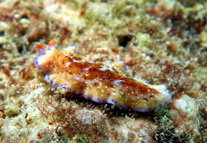Abstract
Polyclads are free-living marine flatworms known for their striking colour and patterns. These animals though frequently encountered are still understudied in the Indian context. The present paper describes three new species, two belonging to the genus Pseudoceros Lang, 1884 and one to the genus Prostheceraeus Schmarda, 1859. Pseudoceros auranticrinis sp. nov. is characterised by whitish cream background colour, brown mottling with numerous white and dark brown spots all over the body except margins and a smooth dorsal surface with orange pseudotentacles, Pseudoceros vishnui sp. nov. is characterised by having purple to violet spots on dorsum with margin made up of blue spots, while Prostheceraeus fuscolineatus sp. nov. is characterised by presence of brown longitudinal lines on dorsum and black erected tentacles. This is the first description of any species under the genus Prostheceraeus from central Indo-Pacific as well as Indian Ocean. Some insights on feeding behaviour of P. vishnui sp. nov. are also provided.
References
Bolanos, D.M., Gan, B.Q. & Ong, S.L. (2016) First records of pseudocerotid flatworms (Platyhelminthes: Polycladida: Cotylea) from Singapore: A taxonomic report with remarks on colour variation. Raffles Bulletin of Zoology, 34, 130–169.
Dixit, S. & Raghunathan, C. (2013) Polyclads of Andaman and Nicobar Islands. Journal of the Andaman Science Association, 18 (2), 165–169.
Dixit, S., Sivaperuman, C. & Raghunathan, C. (2015) Three new records of polyclad flatworms from India. Marine Biodiversity Records, 8, e29.
https://doi.org/10.1017/S1755267214001043Dixit, S., Raghunathan, C. & Chandra, K. (2017) Two new marine flatworms (Polycladida: Pseudocerotidae) from Andaman & Nicobar Islands, India. Zootaxa, 4221 (1), 111–122.
https://doi.org/10.11646/zootaxa.4221.1.5Gosliner, T.M., Behrens, D.W. & Valdes, A. (2008) Indo Pacific Nudibranchs and Sea Slugs. Sea challengers, 2008, 425.
Hyman, L.H. (1959) Some Australian polyclads. Records of the Australian Museum, 25, 1–17.
https://doi.org/10.3853/j.0067-1975.25.1959.653Jie, W.B., Gan, B.Q., Cgen, V.Y. & Kuo, S.H. (2016) Pseudoceros magangensis: a new species of pseudocerotid flatworm (Platyhelminthes: Polycladida) from Taiwan. Platax, 13, 33–50.
Kato, K. (1934) The turbellarians from the neighbourhood of the Mitsui Institute of Marine Biology. Japanese Journal of Zoology, 6, 123–138.
Kato, K. (1937) Three polyclads from Northern Japan. Annotationes zoologicae japonenses, 16 (1), 35–38.
Kato, K. (1938) Polyclads from Amakusa, Southern Japan. Japanese Journal of zoology, 7, 559–576.
Kato, K. (1944) Polycladida from Japan. The Journal of the Sigenkagaku Kenkyusyo, 1 (3), 257–322.
Kuiter, R.K. & Debelius, H. (2009) World Atlas of Marine Fauna. Ikan-Unterwasserarchiv, Frankfurt, 725 pp.
Laidlaw, F.F. (1902) The marine Turbellaria with an account of the anatomy of some species. In: Gardiner, J.S. (Ed.), The Fauna and Geography of the Maldive and Laccadive Archipelagoes: Being the Account of the Work carried on and of the Collections made by an Expedition during the years 1899 and 1900. Vol. 1. The University Press, Cambridge, pp. 282–312.
Lang, A. (1884) Die Polycladen (Seeplanarien) des Golfes von Neapel und der angrenzenden Meeresabschnitte. Eine Monographie. Fauna und Flora des Golfes von Neapel, 11, i–ix + 1–668.
Litvaitis, M.K. & Newman, L.J. (2001) A molecular framework for the phylogeny of Pseudocerotidae (Platyhelminthes, Polycladida). Hydrobiologia, 444, 177–182.
https://doi.org/10.1023/A:1017503124908Montagu, G. (1815) Description of several new or rare animals principally marine, discovered on the south coast of Devonshire. Transactions of the Linnean Society of London, 11, 25–26.
Newman, L.J. & Cannon, L.R.G. (1994) Pseudoceros and Pseudobiceros (Platyhelminthes, Polycladida, Pseudocertotidae) from eastern Australia and Papua New Guinea. Memoirs of the Queensland Museum, 37 (1), 205–266.
Newman, L.J. & Cannon, L.R.G. (1996) New genera of pseudocerotid flatworms (Platyhelminthes; Polycladida) from Australian and Papua New Guinean coral reefs. Journal of Natural History, 30 (10), 1425–1441.
https://doi.org/10.1080/00222939600770811Newman, L.J. & Cannon, L.R.G. (1997) Nine new species of Pseudobiceros (Platyhelminthes: Polycladida) from the Indo-Pacific. The Raffles Bulletin of Zoology, 45 (2), 341–368.
Newman, L.J. & Cannon, L.R.G. (1998) Pseudoceros (Platyhelminthes: Polycladida) from the Indo-Pacific with twelve new species from the Australia and Papua New Guinea. The Raffles Bulletin of Zoology, 46 (2), 293–323.
Newman, L.J. & Cannon, L.R.G. (2003) Marine Flatworms. The World of Polyclads. CSIRO Publishing, Collingwood, 97 pp.
Newman, L.J. & Cannon, L.R.G. (2005) Fabulous Flatworms: a guide to marine polyclads. Version 1. ABRS & CSIRO Publishing, Canberra. [CD-ROM]
Newman, L.J. & Schupp. P. (2002) A new species of pseudocerotid flatworm (Platyhelminthes, Polycladida) from the Indo-Pacific. Micronesica, 34 (2), 177–184.
Noreña, C., Marquina, D., Perez, J. & Almon, B. (2014) First records of Cotylea (Polycladida, Platyhelminthes) for the Atlantic coast of the Iberian Peninsula. ZooKeys, 404, 1–22.
https://doi.org/10.3897/zookeys.404.7122Prudhoe, S. (1978) Some polyclad turbellarians new to the fauna of the Australian coasts. Records of the Australian Museum, 31 (14), 586–604.
https://doi.org/10.3853/j.0067-1975.31.1978.205Prudhoe, S. (1989) Polyclad turbellarians recorded from African Waters. Bulletin of the British Museum of Natural History, Zoology, 55 (1), 47–96.
Sreeraj, C.R. & Raghunathan, C. (2011) New records of pseudocerotid polyclads from Andaman and Nicobar Islands, India. Marine Biodiversity Records, 4, e73.
https://doi.org/10.1017/S1755267211000819Sreeraj, C.R. & Raghunathan, C. (2013) Pseudocerotid polyclads (Platyhelminthes, Turbellaria, Polycladida) from Andaman and Nicobar Islands, India. Proceedings of the International Academy of Ecology and Environmental Sciences, 3 (1), 36–41.
Sreeraj, C.R. & Raghunathan, C. (2015) A report on the coral reef dwelling polyclads of Nicobar Islands, India. Proceedings of the International Academy of Ecology and Environmental Sciences, 5 (2), 83–88.
Sreeraj, C.R., Raghunathan, C., Raghuraman, R., Sudhanshu Dixit & Venkataraman, K. (2015) Polyclads of Andaman and Nicobar Islands. Zoological Survey of India, 2015, 1–100.
Tyler, S., Schilling, S., Hooge, M. & Bush, L.F. (Comp.) (2006–2016) Turbellarian taxonomic database. Version 1.7. Available from: http://turbellaria.umaine.edu (accessed 28 November 2016)
Woodworth, W.M. (1894) Report on the Turbellaria (Albatross-Report 9). Bulletin of the Musueum of Comparitive Zoology at Harvard College, 25 (4), 49–52.

